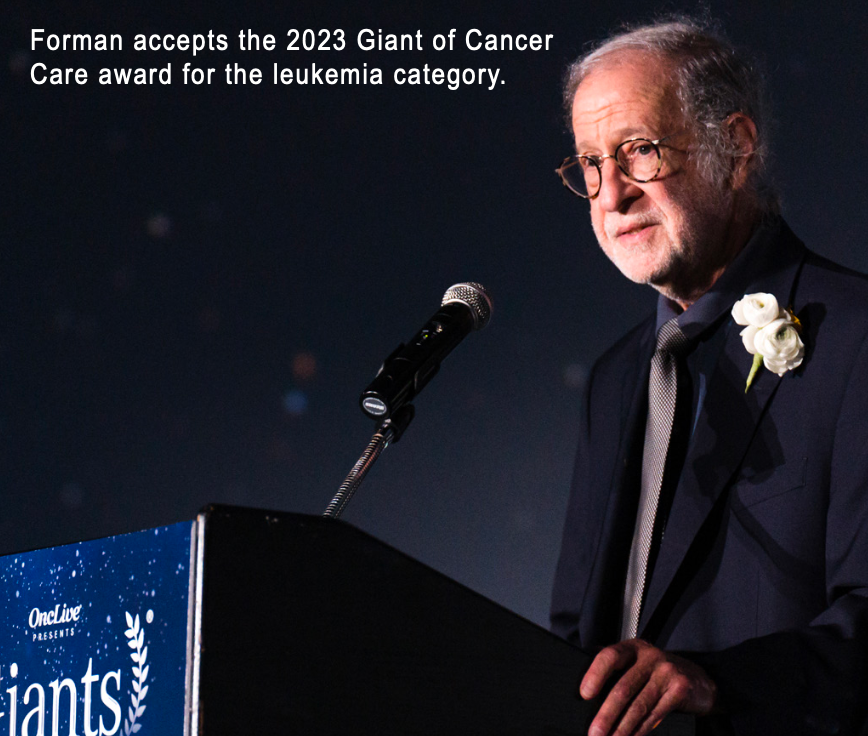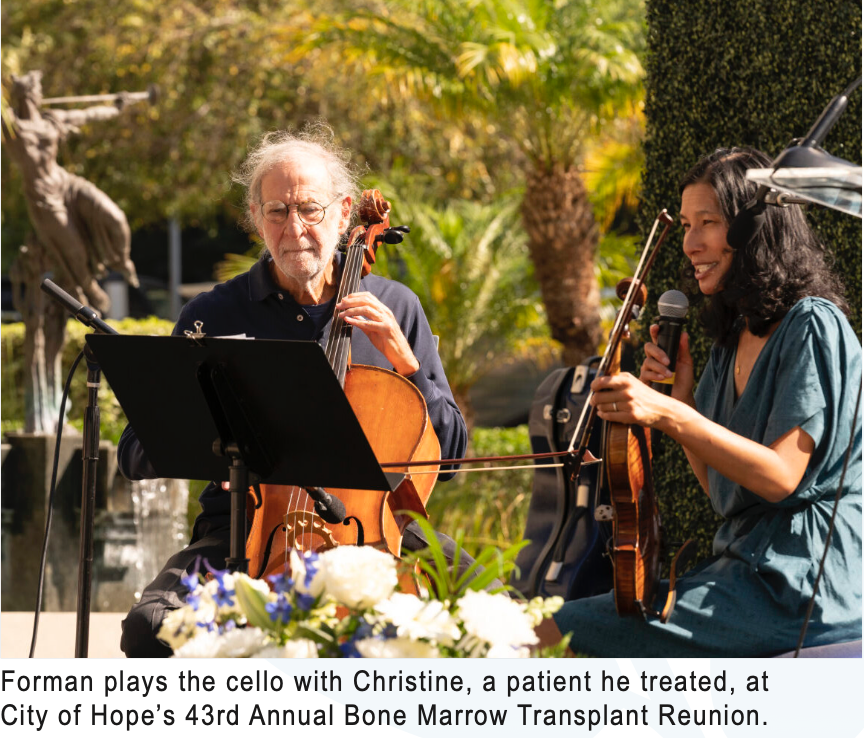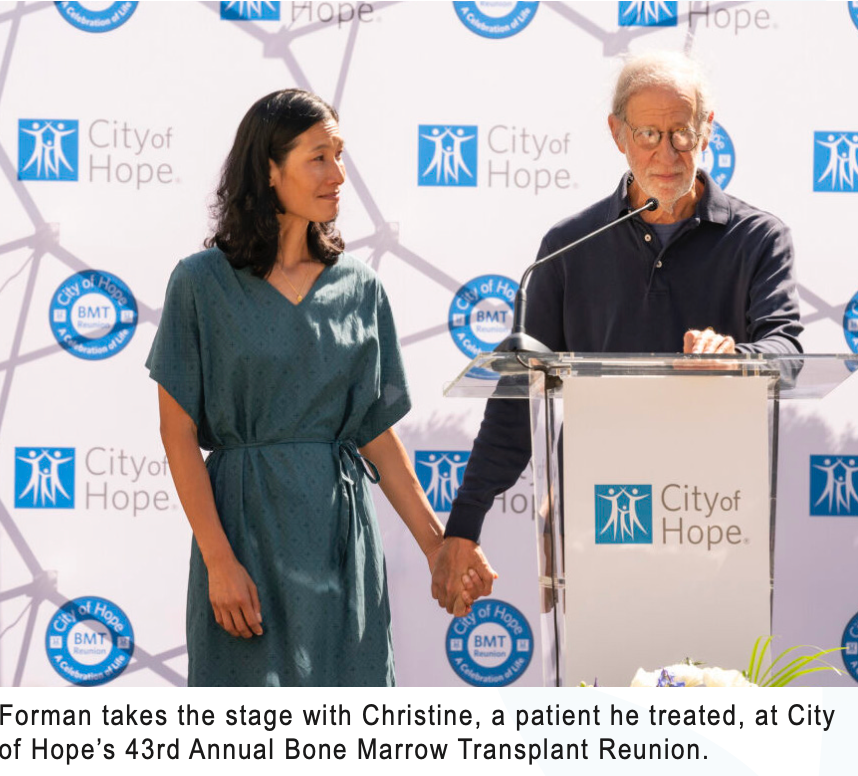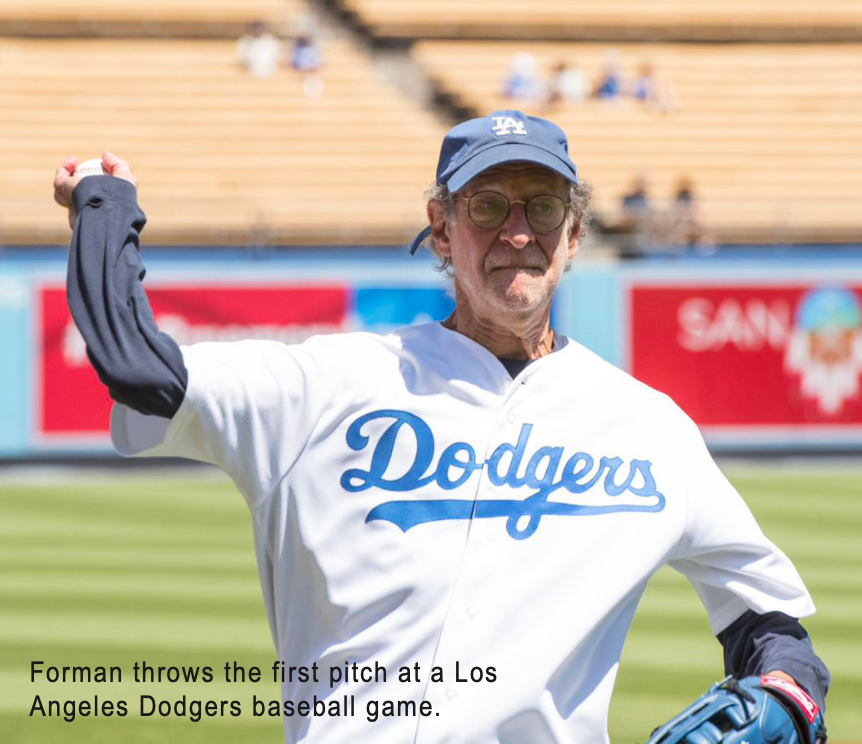Knocking Expectations Out of the Park in the Search for a Cure
Dedication to his patients and the field of hematology spanning decades has led Stephen J. Forman, MD, to break down barriers for treating patients with leukemia and lymphoma.
Stephen J. Forman, MD

Many may ask what it is about City of Hope’s Bone Marrow Transplant (BMT) program that has had the accomplishment of being the only program in the nation with a 1-year survival above the expected rate for 15 consecutive years.1
A part of the answer is the bone marrow transplant program’s former director, Stephen J. Forman, MD, who along with Karl Blume, MD, built and fostered its growth after arriving at City of Hope in 1978. At the time, the newly BMT-formed program was among the first of 6 in the United States. He credits the culture of everyone putting each patient first and attention to detail, as the main reasons City of Hope has accomplished all that it has, while at the same time, conducting research to improve the outcome.1
“Patients notice. It’s very evident that there’s something about the culture here at City of Hope that permeates the 24/7 care throughout the year...the patient is always first and that includes their family, friends, and community in that effort,” Forman explained. Laboratory and clinical research strategies to reduce the risk of relapse, as well as transplant-related complications and late adverse effects have been a special focus for the City of Hope bone marrow transplant team, as a cure has always been their goal.
Forman accepts the 2023 Giants of Cancer Care award for the leukemia category.

He compared observing young transplant physicians grow at his institution with watching young baseball players debut in the major leagues and become hometown heroes. At City of Hope, Forman is the homegrown hero.
“It’s rare in today’s world that one is privileged to know someone who devotes his life, day in and day out, to caring intensely for patients’ well-being, to continually pursuing new knowledge for the betterment of mankind, to instructing and inspiring the next generation of physician-scientists, to committing one’s life to humanity, to treat cancer, to a cause and an organization, and to be as humble as he is brilliant,” colleague Michael A. Caligiuri, MD, said of Forman. “We are all so fortunate to have Steve as our friend and colleague. He raises all boats, making every one of us much, much better simply by working alongside him.”
Forman has put his heart and mind into doing the research to develop new therapies for the treatment of lymphoma and people suffering from leukemia and other cancers. Over the years, the program has had research support (PPG) from the NCI for their work and he and his colleagues wrote a lymphoma Specialized Programs of Research Excellence (SPORE) grant in just 60 days, leading to the approval of the first City of Hope SPORE grant.
“It was one of those remarkable times where we worked night and day,” Forman recalled. “You didn’t want to mess with us during those very intense 60 days of writing and we were thrilled to be approved.”
Forman with Alessandra Ferrajoli, MD, of The University of Texas MD Anderson Cancer Center and Robert Goldsmith, of MJH Life Sciences.

He and his team help develop chimeric antigen receptor (CAR) T-cell therapies for lymphoma as well as identifying new antigens for other cancers. The SPORE grant has since been renewed with Forman serving along with Larry Kwak, MD, PhD. as coprincipal investigators. Even though it was “madness,” he said it showed what can be done when people come together for a common good, working on new ideas, writing, and editing with everyone contributing. It was an institutional family effort.
Aside from the work on lymphoma, Forman and his team of physicians and scientists were also busy conducting research and developing first-in-human clinical trials using CAR T-cells for the treatment of patients with acute lymphoblastic leukemia, acute myeloid leukemia (AML), brain tumors, myeloma, prostate cancer, and ovarian cancer.
In his earlier laboratory work, he worked on the immunology of cytomegalovirus (CMV). Following the cloning of the pp65 viral antigen gene in the laboratory of Art Riggs, PhD, Forman worked with John Zaia, MD, and Don Diamond, PhD, to use the antigen to characterize the immunodominant antigens that led to the development of a CMV vaccine for preventing infection in transplant patients. Then working with Xiuli Wang, MD, PhD, they devised a way to use the CMV vaccine to augment the activity of adoptive bispecific CAR T-cell immunotherapy.
Forman at City of Hope's 43rd Annual Bone Marrow Transplant Reunion.

During this time, Forman and his team also sought to improve outcomes for patients with HIV-related lymphoma. The group's work led to the fifth patient in the world being cured of HIV using stem cells from a donor who was naturally resistant to HIV (CCR5-/-). They hope to continue the pursuit of finding a cure through the transplantation of genetically selected or modified stem cells that will reconstitute HIV-resistant immune function.
His intent to heal patients has led to the admiration of his colleagues, including 2021 Giants of Cancer Care award recipient in lymphoma, Steven T. Rosen, MD. He called Forman “a gifted scientist and clinician. [He’s] a role model for all in our field and has the unique combination of brilliance and sincere empathy.”
Carl H. June, MD, the 2015 Giants of Cancer Care award winner in the immuno-oncology category, added that Forman “is an internationally recognized hematologist and oncologist known for his groundbreaking work in the field of blood cancers. Dr Forman’s work has significantly contributed to the development and refinement of bone marrow transplantation procedures. His leadership and scientific skills have built City of Hope into a premier cancer center for basic and translational development of CAR T cells.”
Elizabeth Lihua Budde, MD, PhD, Christine Brown, PhD, and Forman.

Keeping His Foot on the Pedal
When Forman started at City of Hope over 40 years ago, he worked alongside Blume and Gerhard Schmidt in a brand-new field. In the late 1970s, the bone marrow transplant program rarely performed transplants for individuals older than 30 years. Forman noted that because of work done in the field, the upper age for transplant has increased over time and now there is no age limit. In 1976, the City of Hope team did 6 transplants—last year, they performed nearly 800.2
Working again with Blume and E. Donnall Thomas, MD, the 1990 Nobel Laureate in medicine, they edited the first definitive textbook in the field of hematopoietic cell transplantation.
As director of the City of Hope T Cell Therapeutics Research Laboratories, Forman and his team initiated numerous T-cell immunotherapy first-in-human clinical trials in the past 3 years alone for several settings, including for patients with AML, glioblastoma multiforme (GBM), central nervous system lymphoma, prostate cancer, and ovarian cancer.
Working with his colleagues in clinical and laboratory research and acting as a dialectical partner to help develop new ideas is another role Forman cherishes. Coming together to deliver care alongside Forman are City of Hope’s nurses, scientists, and physicians, who all work in close collaboration hoping to turn incurable diseases into curable ones.
Forman plays the cello with Christine, a patient he treated, at City of Hope's 43rd Annual Bone Marrow Transplant Reunion.

“[We’re] driven by the idea that there is no result we have that is so good that we can just rest on our laurels and that there’s always a challenge that we should not be afraid to meet,” Forman explained.
On an average day, Forman starts by making inpatient rounds on his patients by 7:00 am and then hematologic and solid tumor malignancies. On non-clinic days, he spends his time on laboratory projects focused on cellular immunotherapy and CAR T cells in cancer treatment along with Christine Brown, PhD, Xiuli Wang, MD, PhD, Saul Priceman, PhD, Elizabeth Budde, MD, PhD, Lior Goldberg, MD, and Jamie Wagner, BS.
Some of these projects ask how CAR T-cell immunotherapy can be utilized earlier in the course of the treatment of disease, which may entail moving CAR T-cell therapy to frontline treatment or in some situations combining transplant with CAR T cells. In the CAR T-cell research, he said every clinical trial is important because “even an experiment or protocol that did give the expected result tells you what did not work and makes you think more creatively for how to achieve a better outcome. Often what ends up as a success started out not so successful.”
It’s a lesson he passes on to graduate students when reviewing their experiments as part of their PhD work. He believes that mentoring is bidirectional, as each learns from the other and facilitates all of their creativity.
Forman takes the stage with Christine, a patient he treated, at City of Hope's 43rd Annual Bone Marrow Transplant Reunion.

He also credits Behnam Badie, MD, chief of the Division of Neurosurgery at City of Hope, for teaching him about the brain and central nervous system (CNS) tumors and Mike Jensen, M.D. who had the original idea for treating GBM with CAR T cells delivered directly into the brain and was the person who first introduced Forman to the potential of CAR therapy and mentored him in this research.
Alongside Badie, Christine Brown, the deputy director of the T Cell Therapeutics Research Laboratories at City of Hope they are conducting a series of phase 1 trials targeting IL13Ra2-specific and other antigens for the treatment of patients with recurrent/refractory malignant glioma. Working with Wang and Tanya Siddiqi, MD, their most recent laboratory and clinical work encompasses the treatment of patients with primary CNS lymphoma.
“[Dr Forman] is the quintessential physician/scientist/ teacher—a doctor beloved by his patients, a researcher who has helped shape the field of hematopoietic cell transplantation, and an educator who has taught his peers the art and science of his craft,” said Frederick Appelbaum, MD, the 2019 Giants of Cancer Care award recipient whom Forman praised as someone he’s learned a lot from. “Working with him has been one of the joys of my career,” Appelbaum added.
Forman throws the first pitch at a Los Angeles Dodgers baseball game.

Giving 110% to patients is a given for Forman. Playing and composing music for cello and piano, writing opinion pieces, and being with his children and grandkids are very important aspects of his life, too. Throwing out the first pitch at Dodger Stadium in Los Angeles, California is a dream for many and something Forman, has done a few times. He prepared for a month to ensure he would throw a strike. The advice he was given? Aim for the catcher’s head and it’s less likely you’ll throw a grounder. Each time, he threw one right down the middle for a strike.
Whether he’s enjoying a game, looking under the microscope in the lab, or playing music with his children, Forman puts his focus on his family and work, which he said are the 2 most important things he has.
A Lasting Impact
“All the work I’ve ever done has always been about the future while recalling the past,” Forman explained. As the field of hematology-oncology continues to evolve with new developments to extend survival rates, there is always a need to understand more and use that knowledge to make progress. Making the immune system part of an effective cancer therapy is something Forman says he is proud to be a part of. He believes that every person cured of cancer owes their life to the dedication of many people in the field.
Forman in the dugout during the Los Angeles Dodgers baseball game where he threw the first pitch.

It’s not difficult to see the influence that his research and work as a clinician has had on the field, City of Hope, and patients, but Forman’s impact extends beyond the walls of the hospital. He is the host of the City of Hope’s Annual Bone Marrow Transplant Reunion, which has taken place on campus since 1978, Forman usually plays with a Beatles cover band for a song and dances on the stage with transplant nurses at a picnic for thousands of patients, families, donors, and staff in attendance.
He penned the piece “No, You Don’t Need ‘Closure’” in 2016 for the opinion section of The Wall Street Journal poignantly explaining his view that closure is a myth for those who have lost a loved one to cancer because those people are alive within you and those precious memories are carried forever. Forman noted in his piece that he will often write to the family of a patient who has died in the months following to remain connected and let them know their loved one is an important memory for him and City of Hope.3
“We always focus and are inspired by those people for whom we had success,” Forman said. “Sometimes it’s obvious why it was successful, sometimes it’s mysterious. But the most important people inspiring us to do better in our professional lives are the ones for whom we were not successful. They are the inspirations for why we come to work every day and do what we do, it’s their voices who need to be heard as much as the voices of those who we saved.”
References
- Marquez L. Eileen Smith, M.D., named hematology head at City of Hope. City of Hope. February 14, 2020. Accessed August 9, 2023. https://www.cityofhope.org/breakthroughs/eileen-smith-new-chair#:~:text=For%2015%20consecutive%20years,%20City,Marrow%20Transplant%20Research%20(CIBMTR).
- Easterling M, Bonar S. 15,000 second chances: bone marrow transplant program celebrates new milestone. City of Hope. April 24, 2019. Accessed August 9, 2023. https://www.cityofhope.org/breakthroughs/15000-second-chances
- Forman SJ. No, you don’t need ‘closure’. Wall Street Journal. January 6, 2016. Accessed August 9, 2023. https://www.wsj.com/articles/no-you-dont- need-closure-1452124858



